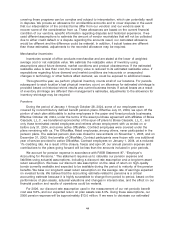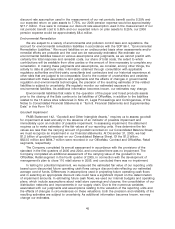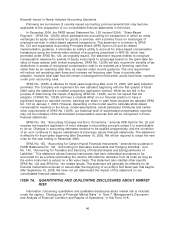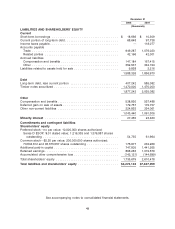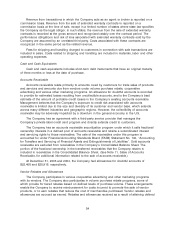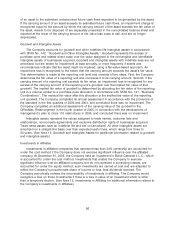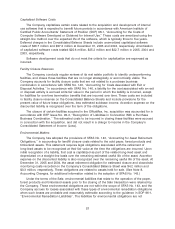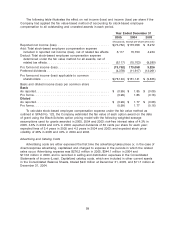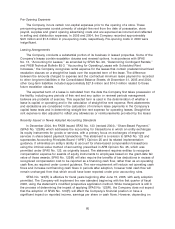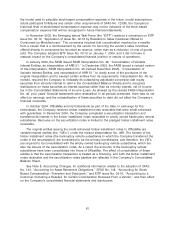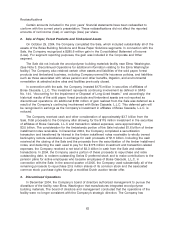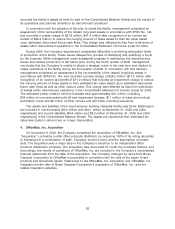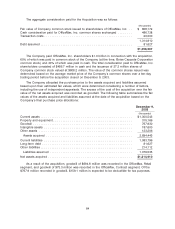OfficeMax 2005 Annual Report Download - page 58
Download and view the complete annual report
Please find page 58 of the 2005 OfficeMax annual report below. You can navigate through the pages in the report by either clicking on the pages listed below, or by using the keyword search tool below to find specific information within the annual report.Revenue from transactions in which the Company acts as an agent or broker is reported on a
commission basis. Revenue from the sale of extended warranty contracts is reported on a
commission basis at the time of sale, except in a limited number of states where state law specifies
the Company as the legal obligor. In such states, the revenue from the sale of extended warranty
contracts is recorded at the gross amount and recognized ratably over the contract period. The
performance obligations and risk of loss associated with extended warranty contracts sold by the
Company are assumed by an unrelated third party. Costs associated with these contracts are
recognized in the same period as the related revenue.
Fees for shipping and handling charged to customers in connection with sale transactions are
included in sales. Costs related to shipping and handling are included in materials, labor and other
operating expenses.
Cash and Cash Equivalents
Cash and cash equivalents includes short-term debt instruments that have an original maturity
of three months or less at the date of purchase.
Accounts Receivable
Accounts receivable relate primarily to amounts owed by customers for trade sales of products
and services and amounts due from vendors under volume purchase rebate, cooperative
advertising and various other marketing programs. An allowance for doubtful accounts is recorded
to provide for estimated losses resulting from uncollectible accounts, and is the Company’s best
estimate of the amount of probable credit losses in the Company’s existing accounts receivable.
Management believes that the Company’s exposure to credit risk associated with accounts
receivable is limited due to the size and diversity of its customer and vendor base, which extends
across many different industries and geographic regions. However, the collectibility of accounts
receivable may be adversely impacted by a downturn in the general economy in the U.S.
The Company has an agreement with a third-party service provider that manages the
Company’s private label credit card program and directly extends credit to customers.
The Company has an accounts receivable securitization program under which it sells fractional
ownership interests in a defined pool of accounts receivable and retains a subordinated interest
and servicing rights to those receivables. The sale of the receivables under this program is
accounted for under Financial Accounting Standards Board (FASB) Statement No. 140, ‘‘Accounting
for Transfers and Servicing of Financial Assets and Extinguishments of Liabilities’’. Sold accounts
receivable are excluded from receivables in the Company’s Consolidated Balance Sheet. The
portion of the fractional ownership in the transferred receivables that the Company retains is
included in receivables in the Consolidated Balance Sheet. (See Note 11, Sales of Accounts
Receivable, for additional information related to the sale of accounts receivable.)
At December 31, 2005 and 2004, the Company had allowances for doubtful accounts of
$22,408 and $25,916, respectively.
Vendor Rebates and Allowances
The Company participates in various cooperative advertising and other marketing programs
with its vendors. The Company also participates in volume purchase rebate programs, some of
which provide for tiered rebates based on defined levels of purchase volume. These arrangements
enable the Company to receive reimbursement for costs incurred to promote the sale of vendor
products, or to earn rebates that reduce the cost of merchandise purchased. Vendor rebates and
allowances are accrued as earned. Rebates and allowances received as a result of attaining defined
54


